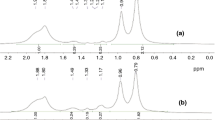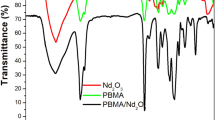Abstract
Nanocomposites containing newly synthesized methacrylate polymer, poly 2-(4-fluorophenyl)-2-oxoethyl-2-methylprop-2-enoate (PFPAMA), and SiO2 nanoparticles in different mass ratios (1, 3, 5, and 7 wt%) were synthesized using the hydrothermal method. The morphological and structural properties of the materials have been examined by SEM, FTIR, TGA, and XRD techniques. The activation energies (Ea) related to thermal decomposition of the nanocomposites were estimated by the Flynn–Wall–Ozawa (FWO) and Kissinger–Akahira–Sunose (KAS) methods using non-isothermal TGA experiments. The thermal stability, glass transition temperature (Tg), and thermal decomposition activation energy (Ea) values of nanocomposites were increased by increasing the SiO2 amount on the composite. The dielectric constant (ε′), dielectric loss factor (ε′′), and ac conductivity of neat PFPAMA and PFPAMA/SiO2 nanocomposites were also measured for the frequency range of 100 Hz to 2 kHz at different temperatures (from 25 to 120 °C). It was seen that the frequency dependence of the dielectric constant and dielectric loss factor decreased with increasing frequency. The biological activities of PFPAMA/SiO2 nanocomposites against gram-positive (S. aureus) and gram-negative (E. coli) bacteria were also tested. The antibacterial effect increased against both bacterial species as the amount of SiO2 in the nanocomposites increased.


















Similar content being viewed by others
References
Mishra RS, Mishra AK, Raju KVSN (2009) Synthesis and property study of UV-curable hyperbranched polyurethane acrylate/ZnO hybrid coatings. Eur Polym J 45(3):960–966. https://doi.org/10.1016/j.eurpolymj.2008.11.0
Zandi-zand R, Ershad-langroudi A, Rahimi A (2005) Silica based organic–inorganic hybrid nanocomposite coatings for corrosion protection. Prog Org Coat 53:286–291. https://doi.org/10.1016/j.porgcoat.2005.03.00
Soykan C, Erol I, Kirbag S (2003) Synthesis and characterization of poly(1,3-thiazol-2-yl-carbomoyl) methyl methacrylate: its metal complexes and antimicrobial activity studies. J App Polym Sci 90(12):3244–3251. https://doi.org/10.1002/app.12981
Ma J, Mo MS, Du XS et al (2008) Effect of inorganic nanoparticles on mechanical property, fracture toughness and toughening mechanism of two epoxy systems. Polymer 49:3510–3523. https://doi.org/10.1016/j.polymer.2008.05.043
Chen C, Justice RS, Schaefer DW, Baur JW (2008) Highly dispersed nanosilica–epoxy resins with enhanced mechanical properties. Polymer 49(17):3805–3815. https://doi.org/10.1016/j.polymer.2008.06.023
Zhang H, Zhang Z, Friedrich K, Eger C (2006) Property improvements of in situ epoxy nanocomposites with reduced interparticle distance at high nanosilica content. Acta Mater 54:1833–1842. https://doi.org/10.1016/j.actamat.2005.12.009
Wu T, Ke Y (2006) The absorption and thermal behaviors of PET–SiO2 nanocomposite films. Polym Deg Stab 91(9):2205–2212. https://doi.org/10.1016/j.polymdegradstab.200
Nayak RK, Dash A, Ray BC (2014) Effect of epoxy modifiers (Al2O3/SiO2/TiO2) on mechanical performance of epoxy/glass fiber hybrid composites. Proc Mat Sci 6:1359–1364. https://doi.org/10.1016/j.mspro.2014.07.115
Jalili MM, Maradian S, Dastmalchian H, Karbasi A (2007) Investigating the variations in properties of 2-pack polyurethane clear coat through separate incorporation of hydrophilic and hydrophobic nanosilica. Prog Org Coat 59:81–87. https://doi.org/10.1016/j.porgcoat.2007.01.01
Dongbo W, Yujie F, Liwei H, Yan T (2006) Effect of wet surface treated nano-SiO2 on mechanical properties of polypropylene composite. J Wuhan Univ of Technol Mater Sci Edu 23(3):354–357. https://doi.org/10.1007/s11595-007-3354-9
Lee NY (2013) Spatially defined hydrophobic coating of a microwell-patterned hydrophilic polymer substrate for targeted adhesion with high-resolution soft lithography. Colloids Surf B 111:313–320. https://doi.org/10.1016/j.colsurfb.2013.06.027
Erol I, Soykan C, Ahmedzade M (2002) Monomer reactivity ratios of the 2-(3-mesityl-3-methylcyclobutyl)-2-hydroxyethyl methacrylate and styrene system from 1H-NMR. J Polym Sci Part A Polym Chem 40:1756–1763. https://doi.org/10.1002/pola.10255
Adachi Y, Ooyama Y, Shibayama N et al (2016) Synthesis of organic photosensitizers containing dithienogermole and thiadiazolo[3,4-c]pyridine units for dye-sensitized solar cells. Dalton Trans 45:13817–13826. https://doi.org/10.1039/C6DT02469F
Jankova K, Hvilsted S (2005) Novel fluorinated block copolymer architectures fuelled by atom transfer radical polymerization. J Fluor Chem 26:241–250. https://doi.org/10.1016/j.jfluchem.2004.11.00
Erol I, Sahin B (2015) Functional styrenic copolymer based on 2-(dimethylamino)ethyl methacrylate: reactivity ratios, biological activity thermal properties and semi-conducting properties. J Fluor Chem 178:154–164. https://doi.org/10.1016/j.jfluchem.2015.07.00
Wang C, Wang AW, Feng J et al (2017) Hydrothermal preparation of hierarchical MoS2-reduced graphene oxide nanocomposites towards remarkable enhanced visible-light photocatalytic activity. Ceram Int 43:2384–2388. https://doi.org/10.1016/j.ceramint.2016.11.02
Saba N, Tahir PM, Jawaid M (2014) A review on potentiality of nano filler/natural fiber filled polymer hybrid composites. Polymers 6:2247–2273. https://doi.org/10.3390/polym6082247
Peng J, Gao W, Gupta BK et al (2012) Graphene quantum dots derived from carbon fibers. Nano Lett 12:844–849. https://doi.org/10.1021/nl2038979
Hou X, Yao S, Wang Z, Fang C, Li T (2021) Enhancement of the mechanical properties of polylactic acid/basalt fiber composites via in-situ assembling silica nanospheres on the interface. J Mater Sci Technol 84:182–190. https://doi.org/10.1016/j.jmst.2021.02.001
Zheng J, Zhu R, He Z et al (2010) Synthesis and characterization of PMMA/SiO2 nanocomposites by in situ suspension polymerization. J App Polym Sci 115(4):1975–1981. https://doi.org/10.1002/app.31258
Boulerba D, Zoukel A (2021) Poly(methyl methacrylate)/SiO2 nanocomposites: effects of the molecular interaction strength on thermal properties. Polym Polym Compos 29:S49–S56. https://doi.org/10.1177/0967391120985710
Zhu A, Shi Z, Cai A, Zhao F, Liao T (2008) Synthesis of core–shell PMMA–SiO2 nanoparticles with suspension–dispersion–polymerization in an aqueous system and its effect on mechanical properties of PVC composites. Polym Test 27(5):540–547. https://doi.org/10.1016/j.polymertesting.2007
Singh A, Kulkarni SK, Khan-Malek C (2011) Patterning of SiO2 nanoparticle–PMMA polymer composite microstructures based on soft lithographic techniques. Microelectron Eng 88(6):939–944. https://doi.org/10.1016/j.mee.2010.12.026
Özdemir E, Soykan C, Coşkun M, Ahmedov MA (1997) Synthesis of phenacylmethacrylate: its characterization and polymerization. J Macromol Sci Part A 34(3):551–557. https://doi.org/10.1080/10601329708014982
Coskun M, Soykan C, Ahmedzade M, Demirelli K (2001) Preparation and thermal degradation of poly(p-substituted phenacyl methacrylates). Polym Deg Stab 72:69–74. https://doi.org/10.1016/s0141-3910(00)00202-0
Burunkaya E, Kesmez Ö, Kiraz N et al (2010) Sn4+ or Ce3+ doped TiO2 photocatalytic nanometric films on antireflective nano-SiO2 coated glass. Mater Chem Phys 120(2–3):272–276. https://doi.org/10.1016/j.matchemphys.2009.11
Bajpai N, Tiwari A, Khan SA et al (2013) Effects of rare earth ions (Tb, Ce, Eu, Dy) on the thermoluminescence characteristics of sol-gel derived and γ-irradiated SiO2 nanoparticles. Luminescence 29(6):669–673. https://doi.org/10.1002/bio.2604
Zhu A, Shi Z, Cai A et al (2008) Synthesis of core–shell PMMA–SiO2 nanoparticles with suspension–dispersion–polymerization in an aqueous system and its effect on mechanical properties of PVC composites. Polym Test 27(5):540–547. https://doi.org/10.1016/j.polymertesting.2007
Aldosari M, Othman AE (2013) Synthesis and characterization of the in situ bulk polymerization of PMMA containing graphene sheets using microwave irradiation. Molecules 18:3152–3167. https://doi.org/10.3390/molecules18033152
Hradil J, Horak D (2005) Characterization of pore structure of PHEMA-based slabs. React Funct Polym 62:1–9. https://doi.org/10.1016/j.reactfunctpolym.200
Hu YH, Chen CY, Wang CC (2004) Viscoelastic properties and thermal degradation kinetics of silica/PMMA nanocomposites. Polym Degrad Stab 84(3):545–553. https://doi.org/10.1016/j.polymdegradstab.200
Flynn JH, Wall LA (1966) A quick, direct method for the determination of activation energy from thermogravimetric data. J Polym Sci Part B Polym Lett 4(5):323–328. https://doi.org/10.1002/pol.1966.110040504
Kissinger HE (1957) Reaction kinetics in differential thermal analysis. Anal Chem 29(11):1702–1706. https://doi.org/10.1021/ac60131a045
Avakian P, Starkweather HW Jr, Kampert WG (2002) Dielectric analysis of polymers. In: Cheng SZD (ed) Handbook of thermal analysis and calorimetry. Elsevier, New York, pp 147–164
Mohomed K, Gerasimov TG, Moussy F, Harmon JP (2005) A broad spectrum analysis of the dielectric properties of poly(2-hydroxyethyl methacrylate). Polymer 46:3847–3855. https://doi.org/10.1016/j.polymer.2005.02.100
Ramesh S, Yahana AH, Aroof AK (2002) Dielectric behaviour of PVC-based polymer electrolytes. Solid State Ion 291:152–153. https://doi.org/10.1016/s0167-2738(02)00311-9
Bhargav PB, Sarada BA, Sharma AK, Rao VN (2010) Electrical conduction and dielectric relaxation phenomena of PVA based polymer electrolyte films. J Macromol Sci Part A Pure Appl Chem 47(131):137
Yakuphanoglu F, Erol I (2004) A novel organic semiconducting material: 2-(3-mesityl-3-methylcyclobutyl)-2-keto-ethyl methacrylate (MCKEMA). Physica B-condends Matter 352:378–382. https://doi.org/10.1016/j.physb.2004.08.018
Slowing II, Vivero-Escoto JL, Wu CW, Lin VSY (2008) Mesoporous silica nanoparticles as controlled release drug delivery and gene transfection carriers. Adv Drug Delivery Rev 60:1278–1288. https://doi.org/10.1016/j.addr.2008.03.012
Saliani M, Jalal J, Kafshdare EG (2015) Effects of pH and temperature on antibacterial activity of zinc oxide nano fluid against Escherichia coli O157: H7 and Staphylococcus aureus. Jundishapur J Microbiol 8(2):e17115. https://doi.org/10.5812/jjm.17115
Jin SE, Jin HE (2021) Antimicrobial activity of zinc oxide nano/microparticles and their combinations against pathogenic microorganisms for biomedical applications: from physicochemical characteristics to pharmacological aspects. Nanomaterials 11(2):263. https://doi.org/10.3390/nano11020263
Karaman DS, Manner S, Rosenholm JM (2018) Mesoporous silica nanoparticles as diagnostic and therapeutic tools: how can they combat bacterial infection? Ther Deliv 9:241–244. https://doi.org/10.4155/tde-2017-0111
Martínez-Carmona M, Gun’ko YK, Vallet-Regí M (2018) Mesoporous silica materials as drug delivery: “the nightmare” of bacterial infection. Pharmaceutics 10(4):279. https://doi.org/10.3390/pharmaceutics10040279
Bernardos A, Piacenza E, Sancenón F et al (2019) Mesoporous silica-based materials with bactericidal properties. Small 15:1900669. https://doi.org/10.1002/smll.201900669
Sefidan AM (2018) Novel silicon dioxide -based nanocomposites as an antimicrobial in poly (lactic acid) nanocomposites films. Nanomed Res J 3(2):65–70. https://doi.org/10.22034/NMRJ.2018.02.002
Kadhum SA (2017) The Effect of two types of nano-particles (ZnO and SiO2) on different types of bacterial growth. Biomed Pharmacol J 10(4):1701–1708. https://doi.org/10.13005/bpj/1282
Manoukian OS, Sardashti N, Stedman T, Gailiunas K et al (2018) Biomaterials for tissue engineering and regenerative medicine. Ref Mod Biomed Sci. https://doi.org/10.1016/b978-0-12-801238-3.64098-9
Ivanova IA, Tasheva-Terzieva E, Angelov O et al (2012) Effect of ZnO thin films on survival of pseudomonas cells. J Nanomed Nanotechol 3(7):2–7. https://doi.org/10.4172/2157-7439.1000148
Li M, Pokhrel S, Jin X, Mädler L, Damoiseaux R (2011) Stability, bioavailability, and bacterial toxicity of ZnO and iron-doped ZnO nano particles in aquatic media. Environ Sci Technol 45:755–761. https://doi.org/10.1021/es102266g
Acknowledgements
This study has been supported by the Afyon Kocatepe University Scientific Research Projects Coordination Unit. The Project Number is 21-FENED-25.
Author information
Authors and Affiliations
Corresponding author
Additional information
Publisher's Note
Springer Nature remains neutral with regard to jurisdictional claims in published maps and institutional affiliations.
Rights and permissions
About this article
Cite this article
Erol, I., Gürler, Z. A new methacrylate polymer functionalized with fluoroarylketone prepared by hydrothermal method and its nanocomposites with SiO2: thermal, dielectric, and biocidal properties. Polym. Bull. 80, 2729–2752 (2023). https://doi.org/10.1007/s00289-022-04195-1
Received:
Revised:
Accepted:
Published:
Issue Date:
DOI: https://doi.org/10.1007/s00289-022-04195-1




